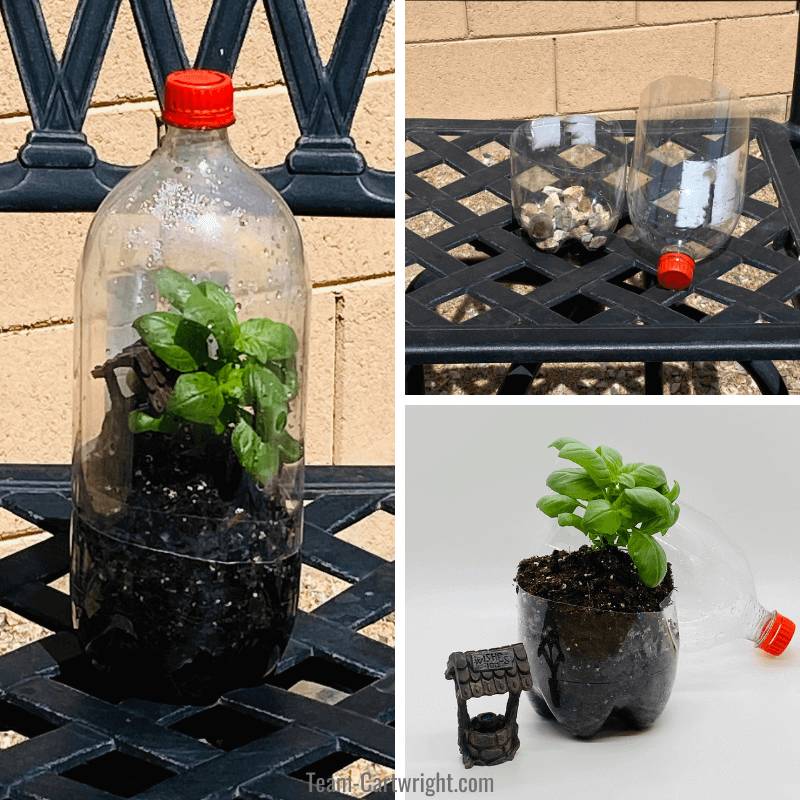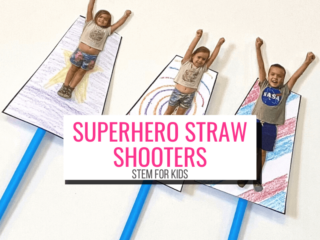How to make a homemade soda bottle terrarium for kids, an earth science activity.
- Ages: Preschool, PreK, Kindergarten, Elementary
- Difficulty: Medium
- Learning: STEM, Biology, Plant Life Cycle
Want to give your child a hands-on experience about how plants grow without having to create a big garden? Even if you do not have a green thumb, you can do this earth science project. And you can do it easily and cheaply with a homemade terrarium.
Don’t worry, this really is simple. You only need a 2-liter bottle, some dirt, and some seeds or a small plant to make a fun, easy to maintain biology experience. This is perfect for Earth Day, or just any time you want to learn more about nature.
Here is how to make a homemade soda bottle terrarium.

This post contains affiliate links. Please see my disclosure for more info.
What's In This Post?
Homemade Soda Bottle Terrarium for Kids
These terrariums are very easy to put together, and they are perfect for little ones. They are a great way to observe and learn about plant growth, even if you are short on space.
My kids loved that they had a little ‘garden’ that was all theirs. They were fascinated by the plants and what we were doing. And they got the new responsibility to help take care of it, which in itself is a great learning opportunity.
(And if you scroll to the bottom of this post you can print these directions!)
Supplies To Make a Soda Bottle Terrarium
You can make this project pretty cheaply as it only takes a few specific items.
- Empty 2 Liter Bottle
- Scissors or Knife
- Soil
- Small Rocks/Pebbles
- Water
- Seeds
- Fertilizer (Optional)
- Activated Charcoal (Optional)
- Moss (Optional)
- Sand (Optional)
- Nature Stickers (Optional)
As you can see, some of these items are optional. If you don’t have them, no big deal!
I will say the fertilizer obviously helps the seeds grow faster. This is helpful for kids because we all know it can be hard to be patient. Seeing their plants grow faster can help keep their interest in the activity.

How To Make a Bottle Terrarium with Kids
This terrarium science project is easy to make, but it will require some adult help.
Step 1: Take your empty 2-liter soda bottle and make sure it is clean. Cut the bottom part off about 5 inches from the bottom of the bottle. (This is a good step for the adult helper.) Put the top piece of the bottle aside.
Step 2: Fill the bottom half of the bottle with a layer of sand and then pebbles or small rocks. This helps with drainage for your terrarium. It’s okay if you don’t have sand available. The rocks really help though.
Step 3: Next, if you’d like, add a small layer of activated charcoal. This is mainly to prevent any bad smells. So it’s helpful if you are keeping your terrarium inside or planning on having several. We left our terrariums outside, so we skipped this step.
Step 4: Add a layer of potting soil. This should go up almost to the top of your bottle half.
Step 5: Add your seeds or small plant to the soil. Water and add fertilizer as you feel necessary.
Step 6: Take the top half of the bottle and place it back over the bottom half. (Keep the cap on.) This creates a terrarium environment where moisture is trapped to help the plant grow. You will need to add water periodically though, as it is not completely sealed.
Step 7: Place your terrarium in your yard or in a window to get light and watch your plants grow!
You will love these amazing activities!
Tips and Notes
Do I need to water my terrarium?
While terrariums do create more of a closed system that lets your plant have more water, you will still need to add water regularly. Maybe not as frequently as other plants, but you will still need to water these every few days.
What can I plant?
You can grow any plant that starts small in these terrariums. Try chia seeds, lima beans, or any other seed you have handy. You can also start larger plants and re-pot them as they get bigger.
This can be a fun way to start a little indoor herb garden. I recommend starting with just a couple until you get a feel for how your plants do in your climate.
How can my child personalize this activity?
Your child can add so much personality to these terrariums.
They can paint a small rock to decorate the inside of their terrarium. You can sometimes find cute little garden decorations at your dollar store too.
Add stickers to the outside of your terrarium to decorate it! Make sure there is still plenty of space for sunlight to get in and be aware that if your terrarium is outside the stickers might not last very long. But my kids didn’t mind any of that. They loved decorating their terrariums.
If you want to take this even further, you can try to make a fairy garden! Learn how here: DIY Fairy Gardens
Safety and Clean Up
This is a pretty safe activity, outside of cutting the bottle. Make sure an adult cuts the 2 liter bottle.
Make sure your children don’t eat any of the rocks, soil, or seeds you are planting.
This can get a little messy, as can any activity with dirt. You can put down newspaper or an old towel under your workstation to make cleaning up easier. This is also a great activity to do outside.

What Learning Is Going On?
This is a great activity to introduce gardening and learn about plants. Actually seeing the process of planting seeds or a small plant and watching it grow is a wonderful experience for kids.
How can you help faciliate this learning?
Parts of a Plant
Talk about the parts of a plant. Plants in a garden have roots, a stem, leaves, maybe flowers. Each of these parts plays an important part in the life of a plant.
Roots: Roots are underground and help bring water and dissolved nutrients into the plant. The roots also help anchor a plant to the ground.
Stem: The stem is the support for the plant. It is what leaves and flowers come off of. Some stems have vascular tissues to help nutrients and water move through the plant. (Learn more about how these vascular tissues work with this capillary action flower experiment.)
Leaves: The leaves of the plant are the above-ground plant organs. They are used for photosynthesis and gas exchange. They are usually green and have a broader, flat surface than the stem.
Flowers: Flowers are the colorful part of a plant made of petals that comes out from the stem. They contain pollen and seeds and can produce fruit. Flowers are a way the plants reproduce.
Ask your child to point out and name the parts of the plants they can see around your home!
Basic Needs of Plants
So what do plants need to live? This project is a great time to talk about the basic needs of living things.
Every living thing needs four basic things. If they don’t get those basic needs, they won’t survive.
(I have found that talking about plants can be an easier way to discuss the idea of death as opposed to starting with animals or people. I’m not trying to tell anyone how to handle that with their kids, that’s for every parent to decide on their own. But our conversations about plants have been super helpful in understanding a life cycle without too much sadness.)
Water: Every living thing needs water. How do plants get their water? How does that differ from how animals or people get water? Do dessert plants need water? All these questions can be great jumping-off points.
Food: Every living thing needs food. Plants make their own food through photosynthesis. How do animals and people get their food?
Air: Every living thing needs air. For animals and humans, that means we need oxygen. We breathe in oxygen and exhale carbon dioxide. Plants ‘breathe’ in carbon dioxide and ‘exhale’ oxygen. This is a big reason why plants are so important for our world.
Space: Every living thing needs space. How much space varies greatly from species to species. Plants need enough room to grow. Animals and people need enough space to move around and have their other needs met.
What are Terrariums?
Okay, so we made a neat little plant container. But what exactly is a terrarium?
A terrarium is a container with soil and plants. They can be sealed, but are able to be opened for maintenance. Usually, they are decorative. Terrariums can also house small animals, such as turtles.
It really is that simple. A terrarium is a small container to grow plants in. The terrariums we made here are great for kids because they are low-cost and easy to put together. They give a great window into how plants grow.
These terrariums bring the outdoors inside and work well in almost any space.
Make a Personalized Garden!
These terrariums aren’t that big, but they are a little personal garden. Your child can choose what to plant. They can be responsible for caring for it. And they can get so many insights into the natural world, all for almost no cost and with minimal space.
What are you going to plant in your terrarium?

Let’s find your next must-do activity!
Free Printable DIY Soda Bottle Terrarium Instructions

How To Make a Soda Bottle Terrarium
Make your own garden you can have anywhere! Easy and cheap homemade terrariums are perfect for kids.
Materials
- Cleaned Out 2 Liter Bottle
- Rocks/Gravel
- Potting Soil
- Seeds/Small Plant
- Water
- Sand (Optional)
- Activated Charcoal (Optional)
- Fertilizer (Optional)
Tools
- Knife or Scissors
Instructions
- Take your soda bottle and cut it about 5 inches up from the bottle. (And adult should do this part.) Set the top half aside for later.
- Add sand to the bottom of the bottle, followed by small rocks or gravel. (Use what you have, all 3 work and you can use more than one.)
- Add a layer of activated charcoal is you are going to have your terrarium in a small space and are worried about potential odors.
- Put potting soil in next.
- Add your seeds or small plant and water it.
- Place in any little garden decorations you would like.
- Take the top half of your bottle and gently place it back over the top of your terrarium. Overlap it a bit so the container is somewhat sealed.
- Enjoy your terrarium!
Notes
Safety
It can be challenging to cut the soda bottle. It is best if an adult does this.
Tips
You will still need to water your terrarium every few days. Yes, the lid does help keep some of the water from evaporating. But these terrariums are not fully sealed, so they still need water regularly.








